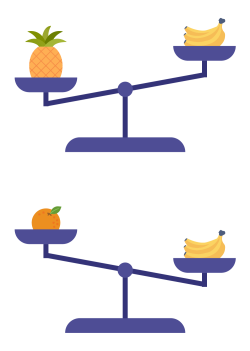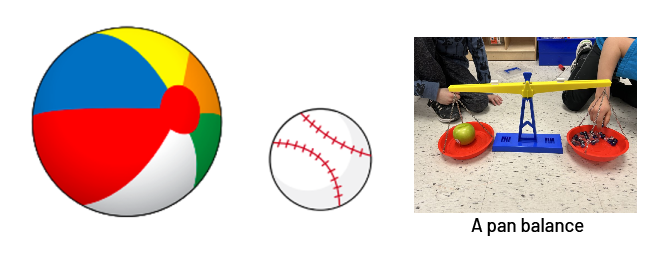E2.4 Compare, estimate, and measure the mass of various objects, using a pan balance and non-standard units.
Skill: Estimating the Mass of Various Objects
In the primary grades, students make estimates using non-standard units, developing the ability to estimate using their senses (for example, comparing the mass of two objects by weighing them based on the feeling of holding them in their hands) or prior knowledge.
Benchmarks Associated with the Attribute of Mass
According to Lindsay and Scott (2005), it is very difficult to develop benchmarks for the attribute mass because of the difference between visual acuity and tactile acuity. For example, sight generally makes it possible to identify very small differences in length between two objects. On the other hand, it is rather difficult to discern a small difference in mass (for example, difference of less than 100 grams). In addition, the size of an object sometimes influences the perception that we have of its mass, Students often believe that a larger object must have greater mass than a smaller object. They must learn to recognize that the mass of an object depends on the density of the matter of which it is composed (for example, a bucket filled with rocks has a greater mass than the same bucket filled with feathers).

Teachers should provide students with multiple opportunities to weigh various objects to help them develop benchmarks for mass. In the primary grades, even if students are familiar with the kilogram, they need to establish mass benchmarks with non-standard units (for example, the mass of a ball of play dough).
Develop and use benchmarks to estimate mass. Students who have developed a repertoire of benchmarks and use them regularly are more successful and comfortable estimating. Estimating the measurement of the attribute is done by comparing it with a benchmark.
Source: translated from Guide d’enseignement efficace des mathématiques, de la maternelle à la 3e année, Mesure, p. 15.
Skill: Measuring the Mass of Various Objects Using a Pan Balance and Non-standard Units
The act of measuring involves a series of reflections, decisions and actions that lead to obtaining and communicating an accurate measurement appropriate to a given context. This involves a number of steps that are the same for all the attributes studied in the primary grades: length, area, capacity, mass and time. Although the number and identification of these steps vary somewhat among researchers, they can generally be articulated in sequence as follows:
Steps in the Act of Measuring
- determine the attribute to be measured;
- choose the unit;
- determine the measurement;
- communicate the result.
The table below provides insight into these steps in relation to mass.
|
Step |
Questioning |
|
Determine the attribute to be measured |
”Liam wants to carry a bag of marbles, a small box of nails, and a ring full of wrenches in his wagons. He knows that the first wagon can hold the equivalent of 10 bolts; the second wagon, the equivalent of 20 bolts; and the last wagon, the equivalent of 30 bolts. What should he do before he chooses which items to put in each wagon?“ (Liam must determine the mass of each group of objects) |
|
Choose the unit of measurement |
”What units can he use?“ (He can use bolts.) |
|
Determine the measure |
”How can he determine the mass of each of the groups of objects?“ (Liam uses a two-pan balance and determines the mass of each group of objects using the bolts.) |
|
Communicate the result |
”How does he communicate his result?“ (Liam places each group of objects in the cars corresponding to the mass found.) |
Note:
It is important for the teacher to ask questions such as:
- ”How did you determine that mass?“
- ”What is the mass of the object?“
- ”Which object has the largest, smallest mass?“
It is also important that students use words that refer to the attribute (for example, ”Which object has the greatest mass?“ not ”Which object is the largest?“
Source: translated from Fiche de la maternelle à la 3e année Attribut masse.
When first exploring an attribute of an object, it is best for teachers to encourage students to choose a non-standard unit of measurement first, so that they can focus on the attribute rather than the tool and the more abstract standard units.
Source: translated from Guide d’enseignement efficace des mathématiques, de la maternelle à la 3e année, Mesure, p. 83.
Mass is measured by finding the number of defined units needed to equal the mass of an object. Any object can be used as a defined unit of mass if it is part of a set of uniform objects with the same mass.
Two-pan balance scales or spring scales are used to indirectly compare and measure the mass of an object.
- Before measuring, ensure that the two pans on the balance are “balanced” or the spring scale is set to start at zero. This is equivalent to eliminating gaps or overlaps when measuring other attributes.
- For a balance scale, place the object on one pan and add units of mass to the other pan until the two pans balance.
- For spring scales, place the object on the spring scale and record the distance the spring scale moves; remove the object and replace it with just enough units of mass to pull the spring down the same distance.
- Count how many units it takes to match the object.
If different-sized units are used to match an object’s mass more exactly, each unit is counted and tracked separately. For example, if 5 small washers equal 1 large washer, then 2 large washers and 3 small washers could be written as \(2\frac{3}{5}\) large washers.
Source: The Ontario Curriculum. Mathematics, Grades 1-8 Ontario Ministry of Education, 2020.
The Inverse Relationship of Mass
The number of units required to determine the measurement of mass is inversely proportional to the size of the measurement unit used, so the smaller (or larger) the mass measurement unit used, the larger (or smaller) the number of units required to determine the mass.
Example
In a Grade 3 math activity centre, Justin must find the mass of his lunch box using the materials provided as units: magnets, interlocking cubes, and beans. Which unit is larger? Which is smaller?
|
Unit Used |
Number Needed to Find the Mass of My Lunch Box |
|
Magnets |
10 |
|
Interlocking cubes |
50 |
|
Beans |
400 (4 containers) |
The magnet is the unit with the greatest mass because less of them are needed to determine the mass of the lunch box. The bean is the unit with the smallest mass, because it takes more of them to determine the mass of the lunch box.
Source: translated from Fiche de la maternelle à la 3e année Attribut masse, p. 3.
No Relationship
It is also important for teachers to provide students with activities that allow them to explore situations in which there is no relationship. This type of activity helps students understand the importance of checking a conjecture before concluding that it is true or making a generalization. The example below illustrates that some students mistakenly believe that there is a relationship between the size of an object and its mass or capacity.
Example
The teacher gives each team four eggs of different sizes and masses and asks them to place them in any order. When all teams have completed this task, the teacher gathers the students and asks each team to explain the order in which they placed the eggs. According to Lindsay and Scott (2005, pp. 3 and 5), most students will place them in order of height. If so, the teacher asks them if placing them in order of increasing mass would change the order. According to the same authors, for most students, believing that there is a direct relationship between size and mass, the order will not change.
 Image Eggs of different sizes are placed in a decreasing order: Dark blue egg is the largest, Yellow
egg, Light blue egg, And the red egg is the smallest.
Image Eggs of different sizes are placed in a decreasing order: Dark blue egg is the largest, Yellow
egg, Light blue egg, And the red egg is the smallest.
Teachers then ask students to estimate the mass by weighing them, check their estimate using a pan balance, and place the eggs in ascending order of mass.

Teachers then lead students to conclude that there is no direct relationship between the size of an object and its mass by asking questions such as:
- Which egg has the greatest mass?
- Did it also have the largest size?
- Which egg has the smallest mass?
- Was it also the smallest size?
- What can we say about the largest egg in relation to its mass?
Since ”our perception of mass is much less sophisticated than our visual judgment of length“ (Lindsay & Scott, 2005), it is important that students experience many similar activities with other objects (for example, boxes, trucks, balls).
Source: translated from Guide d’enseignement efficace des mathématiques, de la maternelle à la 3e année, Mesure, p. 70, 74.
Skill: Comparing Masses
The act of comparing involves comparing two objects based on the same attribute, such as mass.
The measurement of one attribute of two objects is compared either by direct or indirect comparison. From a very young age, children compare the measurement of one attribute of two objects by direct comparison (for example, the height of the milk in two glasses, the thickness of one cookie compared to another, the distance of the throw of two different stones). They then communicate the result descriptively rather than quantitatively (for example, ”My glass has more milk in it than yours; my cookie is thinner than yours; I can throw the small stone farther than the big stone.“)
When it is difficult or impossible to directly compare two objects based on the same attribute, an indirect comparison can be made, by comparing the attribute measurement for each of the objects to a third measurement.
Source: translated from Guide d’enseignement efficace des mathématiques, de la maternelle à la 3e année, Mesure, p. 87-89.
Example
Students directly compare the mass of two objects by holding them in each hand (weighing).

Example
Students indirectly compare two objects to see which has the greater mass by placing them on a pan balance or using a third object.
 Image Two scales, the first one compares the weight of a pineapple and a bunch of bananas, the
pineapple is the
heavier. The second compares the weight of an orange and a bunch of bananas, the bananas are heavier.
Image Two scales, the first one compares the weight of a pineapple and a bunch of bananas, the
pineapple is the
heavier. The second compares the weight of an orange and a bunch of bananas, the bananas are heavier.
Source: The Ontario Curriculum. Mathematics, Grades 1-8 Ontario Ministry of Education, 2020.
Knowledge: Attribute - Mass
Mass is the amount of matter in an object.
Only the kind of matter that makes up an object influences its mass. Thus, the mass of an object does not vary depending on where it is located on Earth (or in space). The mass of an object is determined using, for example, a two-pan balance.
Note: Mass and weight should not be confused. The weight of an object is the force exerted on it by a celestial body. It is determined with a dynamometer and is expressed in newtons (N). The weight of an object varies according to its mass and according to where it is located on Earth (or in space).
Example
The mass of an object does not depend on its size.

Source: translated from Fiche de la maternelle à la 3e année Attribut masse, p. 1.
Knowledge: Non-Standard Units
Common objects, such as rocks, cubes, are non-standard units of measurement that can be used to determine mass.
